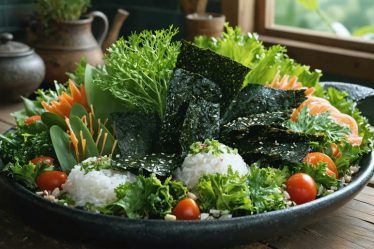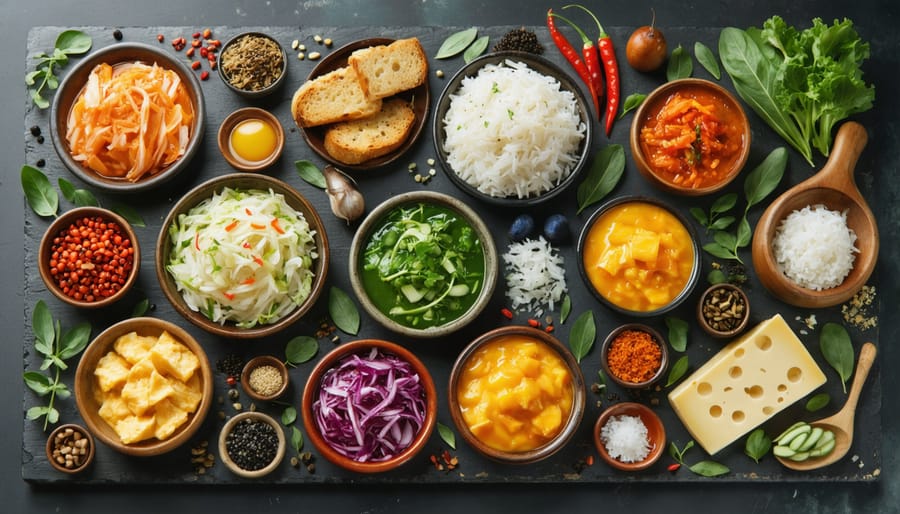
Imagine discovering that the tangy sourdough bread you love, the kombucha you sip every morning, and even your favorite skincare products all share one ancient secret: fermentation. This transformative process isn’t just a trendy buzzword – it’s a fundamental force that has shaped human civilization for thousands of years. From preserving food in times before refrigeration to creating some of the world’s most beloved flavors, fermentation has been quietly revolutionizing our relationship with food, health, and beauty.
When microscopic organisms like bacteria and yeast break down compounds in food, they don’t just prevent spoilage – they create entirely new nutrients, unlock hidden flavors, and generate beneficial compounds that can boost our gut health and immune system. This natural process has become increasingly relevant in our modern world, where probiotic-rich foods and sustainable practices are more important than ever.
Whether you’re a curious home cook, a health enthusiast, or someone interested in sustainable living, understanding fermentation opens up a world of possibilities. It’s the magic behind chocolate’s complex flavor, coffee’s rich aroma, and the satisfying fizz in your favorite craft beer. Let’s explore why this ancient practice remains one of our most powerful tools for creating delicious, nutritious, and sustainable food for the future.
The Science Behind the Magic
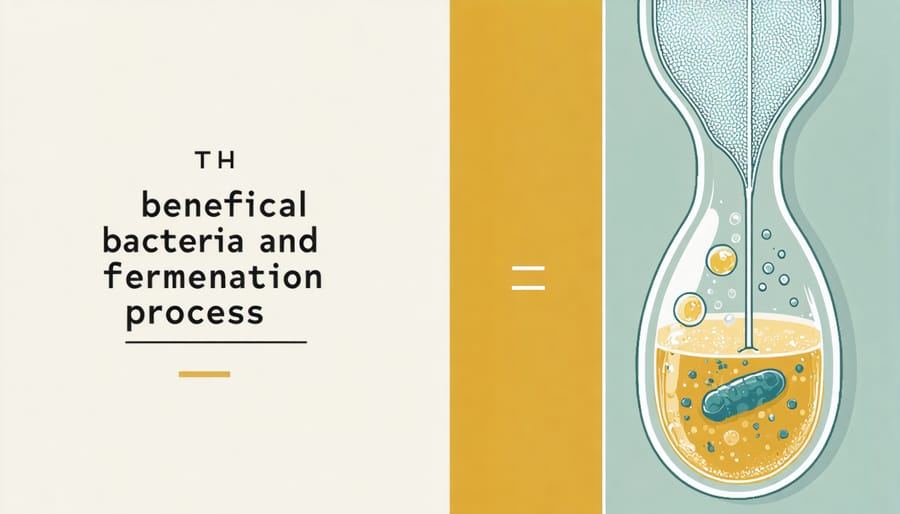
Your Gut’s Best Friend
Think of your gut as a bustling neighborhood where trillions of tiny residents work together to keep you healthy. When you incorporate fermented foods into your mindful eating habits, you’re essentially sending in the friendly neighbors your gut has been craving.
These probiotic-rich foods work their magic by introducing beneficial bacteria that help break down nutrients, making them easier for your body to absorb. It’s like having a personal translation team in your digestive system! The good bacteria from fermented foods also form a protective barrier in your gut, strengthening your immune system and helping ward off unwanted visitors.
What I love most about fermented foods is how they create this beautiful ripple effect throughout your body. When your gut is happy, you might notice improved digestion, clearer skin, and even better mood regulation. It’s fascinating how something as simple as adding a spoonful of yogurt to your breakfast or enjoying some tangy kimchi with dinner can make such a difference in how you feel.
Nature’s Food Preserver
Before the advent of modern refrigeration, our ancestors faced a constant challenge: how to keep food fresh and edible for longer periods. That’s where the magic of fermentation came in! This natural process has been a trusted food preservation method for thousands of years, helping communities survive long winters and uncertain times.
Think of it as nature’s own preservation system. When I visited my grandmother’s kitchen as a child, I was fascinated by her rows of preserved vegetables in mason jars – a tradition passed down through generations. This time-tested method doesn’t just keep food from spoiling; it transforms simple ingredients into nutrient-rich delicacies.
From Korean kimchi and European sauerkraut to Indian pickles and Japanese miso, cultures worldwide have relied on fermentation to extend their food’s shelf life. What’s particularly amazing is that these preserved foods often taste better and become more nutritious over time. The process naturally creates beneficial compounds and probiotics while maintaining the food’s essential nutrients – something our ancestors knew instinctively, even before science could explain why.
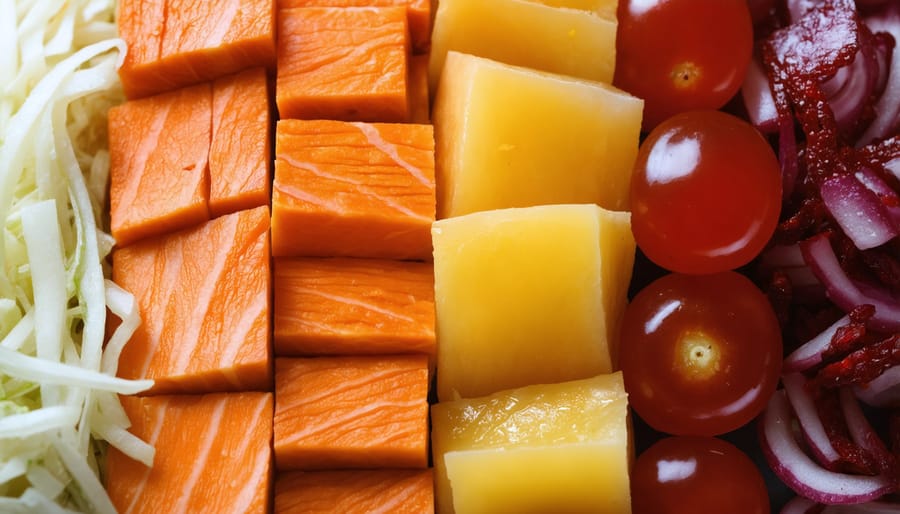
A World Tour of Fermented Treasures
Asian Fermentation Traditions
I’ll never forget my first time stepping into my friend Mai’s kitchen, where the tangy aroma of fermenting kimchi filled the air. Like many Asian cultural food traditions, fermentation isn’t just about preservation – it’s about creating complex flavors and maintaining wellness through generations.
Take kimchi, for instance. This Korean staple transforms simple cabbage into a probiotic-rich powerhouse through a beautiful dance of salt, time, and beneficial bacteria. The same goes for Japanese miso, where soybeans and koji work together for months (sometimes years!) to create that unmistakable umami flavor we’ve all come to love in our favorite soups and marinades.
Let’s not forget about kombucha, which has taken the Western world by storm. This effervescent tea, originally from Northeast China, proves that fermentation can turn something as simple as sweetened tea into a refreshing, gut-healthy beverage. And have you tried Filipino atchara? This fermented green papaya condiment adds the perfect tangy kick to any meal while helping with digestion.
What amazes me most about these Asian fermentation practices is how they’ve survived countless generations, carrying both flavor and wisdom forward. They remind us that sometimes the most powerful health solutions are found in our ancestors’ kitchens, not modern laboratories.
European Fermentation Heritage
When I think about European fermentation traditions, I’m always amazed by how these age-old practices have shaped not just our food culture, but entire ways of life. Take sauerkraut, for instance – this humble fermented cabbage has been a staple in German households for centuries, traditionally prepared in autumn when cabbages were abundant and needed preserving for the winter months.
The art of cheese-making in Europe tells an equally fascinating story. From the caves of Roquefort in France to the Alpine dairy farms of Switzerland, each region has developed its own unique fermentation techniques, passed down through generations. I remember visiting a small cheese maker in the French countryside who still uses the same wooden tools her grandmother once used – there’s something magical about that connection to the past.
Sourdough bread, with its characteristic tang and chewy texture, represents another cornerstone of European fermentation heritage. The practice of maintaining a sourdough starter has seen a beautiful revival in recent years, with many home bakers discovering the joy of working with wild yeasts and bacteria that our ancestors relied upon.
And let’s not forget wine-making! This ancient practice has evolved into both an art and science, with each European wine region developing distinct fermentation methods that reflect their local climate, soil, and traditions. It’s incredible how these time-honored techniques continue to influence modern food culture while maintaining their authentic charm.
Middle Eastern and African Delights
The rich traditions of Middle Eastern and African fermentation have always fascinated me, especially after experiencing these unique flavors during my travels. One of my favorite discoveries was kefir, a fermented dairy drink that’s been nourishing communities for centuries. While many of us know Greek yogurt, its Middle Eastern cousin, labneh, offers an even tangier, creamier experience that’s absolutely divine spread on warm pita bread.
In African cuisine, fermented grains take center stage. The beloved injera, Ethiopia’s sourdough-risen flatbread, isn’t just delicious – it’s a testament to how fermentation can transform simple teff flour into a nutritious, easily digestible staple. During my visit to a Ethiopian restaurant last year, the owner shared how the fermentation process not only creates that distinctive tangy flavor but also increases the bread’s nutritional value.
Speaking of grains, kishk – a fermented mixture of bulgur wheat and yogurt – shows how Middle Eastern communities have masterfully combined different fermentation techniques. This versatile ingredient can be dried and stored for months, making it a brilliant example of how fermentation served as a natural preservation method long before refrigeration.
These traditional foods aren’t just about sustenance; they’re about community. In many African households, the process of making fermented foods like ogi (fermented cereal porridge) or garri (fermented cassava) brings families together, with recipes and techniques passed down through generations.
Getting Started with Home Fermentation
Essential Tools and Ingredients
Getting started with fermentation doesn’t require a huge investment – you’ll be surprised how many items you already have in your kitchen! As someone who was initially intimidated by the process, I can tell you that having the right essential kitchen tools makes all the difference.
First, you’ll need clean glass jars with tight-fitting lids – Mason jars are perfect for beginners. I started with a few different sizes, which gives you flexibility for various projects. Fermentation weights are helpful to keep vegetables submerged in brine, though clean stones can work in a pinch (just like my grandmother used to do!).
For measuring ingredients, you’ll need basic kitchen scales and measuring spoons. Salt is crucial – opt for pure sea salt or kosher salt without anti-caking agents. If you’re planning to make kombucha, you’ll want to invest in a large glass jar with a breathable cloth cover.
Other helpful items include:
– Wooden spoons or chopsticks for packing vegetables
– pH strips for monitoring acidity (optional but useful)
– Wide-mouth funnel for filling jars
– Labels and marker for tracking dates
– Fresh, organic produce
– Filtered water (chlorinated water can inhibit fermentation)
Remember, you don’t need everything at once – start with the basics and build your collection as you explore different fermentation projects!
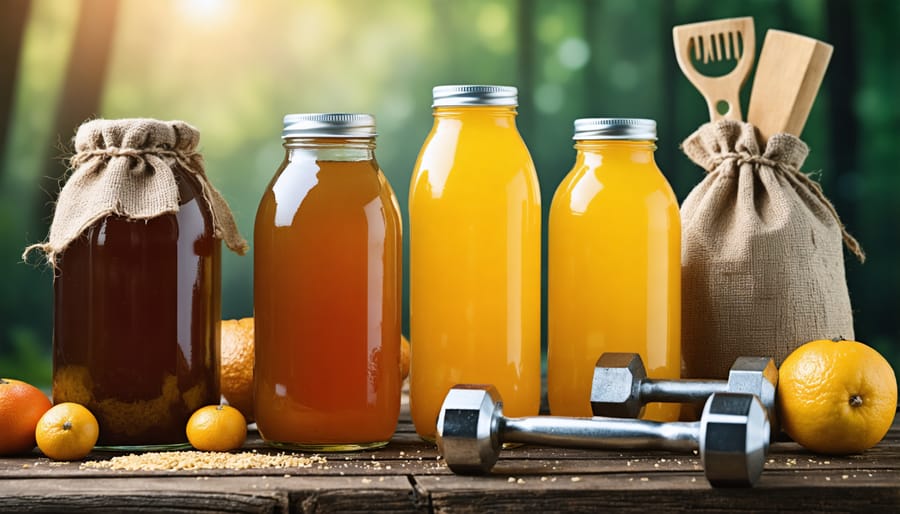
Your First Fermentation Project
Ready to dip your toes into the wonderful world of fermentation? Let’s start with something simple yet rewarding – homemade sauerkraut! It’s the perfect beginner project that’ll give you a taste of fermentation magic with just two ingredients: cabbage and salt.
I remember my first fermentation project feeling like a science experiment in my kitchen. Trust me, if I could do it, so can you! Here’s what you’ll need: one head of cabbage, two tablespoons of sea salt, a clean jar, and a bit of patience.
Start by shredding your cabbage finely and sprinkling it with salt. Now comes the fun part – massage that cabbage like you’re giving it a spa treatment! You’ll notice it starting to release water and become softer. Pack it tightly into your jar, making sure the liquid covers the cabbage (add a bit of saltwater if needed). Leave about an inch of space at the top.
Place your jar in a cool, dark spot for about 5-7 days. Each day, you’ll notice subtle changes in smell and texture – that’s the good bacteria doing their thing! When it reaches a tangy flavor you enjoy, pop it in the fridge.
The best part? This isn’t just a cooking project; it’s your first step into a time-honored tradition of food preservation that’s been bringing people together for generations. Plus, you’ll have the satisfaction of saying, “I made that!” when serving your homemade sauerkraut at your next gathering.
Beauty and Wellness Benefits
The beauty industry has embraced fermentation for good reason – these powerful processes don’t just benefit our gut health, they can transform our skin and overall wellness too. I discovered this myself when I started incorporating fermented skincare into my routine, and the results were genuinely surprising.
Fermented ingredients in beauty products are more easily absorbed by our skin because the fermentation process breaks down molecules into smaller, more penetrable forms. Think of it as pre-digesting the beneficial compounds, making them more bioavailable for our skin cells to use. This means better hydration, enhanced collagen production, and more effective delivery of antioxidants.
Many Korean beauty brands have long recognized this secret, incorporating fermented ingredients like galactomyces (a type of yeast) and fermented tea extracts into their formulations. These ingredients help combat signs of aging, brighten the complexion, and strengthen the skin barrier – all while being gentler on sensitive skin than their non-fermented counterparts.
Beyond skincare, fermented wellness products are gaining popularity for their ability to support overall health. From kombucha-based hair treatments to fermented supplements, these products align perfectly with personalized nutrition benefits and holistic wellness approaches.
The beauty of fermented ingredients lies in their dual action: they not only provide direct benefits to our skin and body but also support our internal wellness through their probiotic properties. When used consistently, they can help balance our skin’s microbiome, reduce inflammation, and promote a healthier, more radiant complexion from the inside out.
Remember, whether you’re using fermented skincare products or consuming fermented foods, the key is consistency and patience. Just as with any natural approach to beauty and wellness, the results build over time, creating lasting benefits that go beyond surface-level improvements.
As we wrap up our fermentation journey, I’m reminded of a conversation I had with my neighbor Sarah, who was initially intimidated by the idea of fermenting foods at home. Like many of us, she thought it was something best left to the experts. But here’s the beautiful truth: fermentation has been a part of human culture for thousands of years, practiced by home cooks long before modern technology existed.
The beauty of fermentation lies in its simplicity and accessibility. Whether you start with a basic kombucha brew, try your hand at homemade yogurt, or experiment with traditional kimchi, there’s a fermentation project perfect for every comfort level and schedule. Many fermented foods require just a few basic ingredients and some patience – no fancy equipment necessary!
In our fast-paced world, incorporating fermented foods into our daily routines isn’t just about following a trend; it’s about reconnecting with traditional food wisdom while supporting our health and well-being. From improving digestion to boosting immunity, the benefits are clear and scientifically backed.
Remember, every small step counts. Maybe you’ll start by adding a spoonful of sauerkraut to your lunch, or swapping your regular dressing for kefir-based alternatives. Whatever your approach, embracing fermentation can be a delicious adventure that connects you to both ancient traditions and modern wellness practices.

